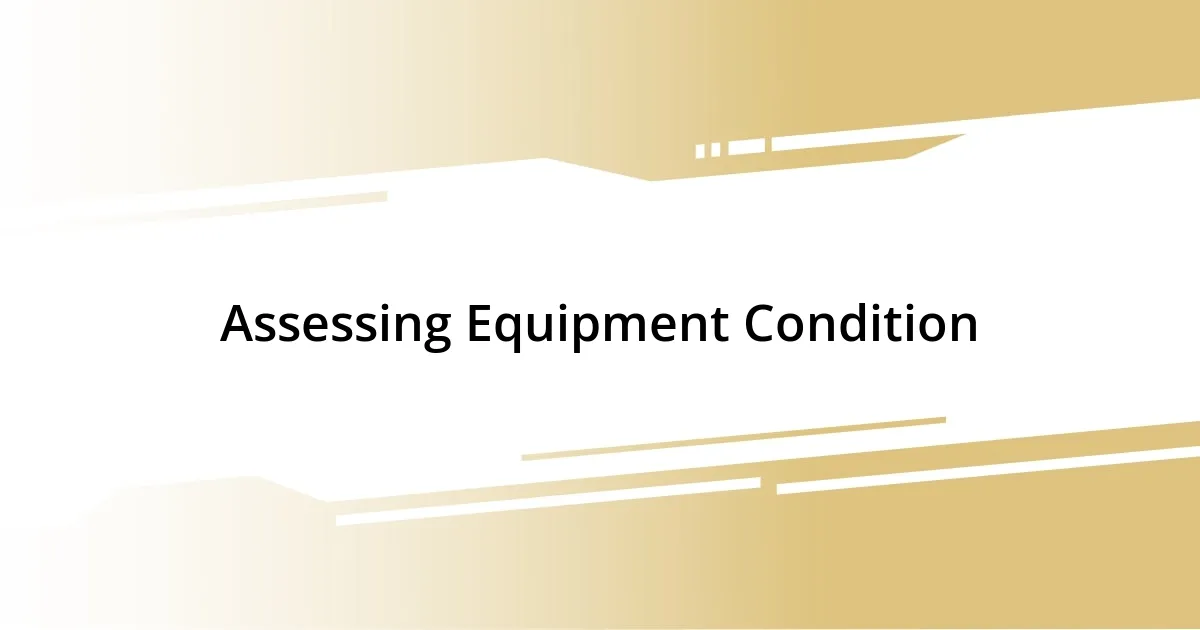Key takeaways:
- Start with a visual inspection and check for damage or wear to assess old equipment’s condition before powering it on.
- Proper cleaning, maintenance, and using quality replacement parts can significantly enhance the performance of vintage test equipment.
- Documenting the restoration process, including notes and photos, helps streamline future repairs and reinforces learning from the experience.
- Reviving old equipment can be emotionally rewarding, fostering resilience and a sense of community with fellow enthusiasts.

Assessing Equipment Condition
When assessing the condition of old test equipment, I often start with a visual inspection. I remember the time I picked up an oscilloscope that looked more like a relic than a tool. It was covered in dust and had a few rusty knobs. At that moment, I wondered if I should even bother turning it on. But stunningly, once I cleaned it up, it powered on!
Next, I like to check for any signs of damage or wear. I remember conducting a thorough check on an old multimeter, and I was shocked to find a corroded battery compartment. Seeing that corrosion felt like a punch to the gut because I had hopes of reviving it. It made me realize how crucial it is to inspect internal components before getting too excited about the potential of older gear.
Finally, testing functionality is essential. Recently, I powered up an ancient function generator I had salvaged from a neighbor’s garage. The anticipation was nerve-wracking. Would it work? When it beeped to life, I felt a rush of joy and nostalgia. It reminded me that even old equipment can surprise us, but you truly must investigate thoroughly before assuming what it can or cannot do.

Cleaning and Maintenance Tips
Proper cleaning and maintenance can breathe new life into old test equipment. I recall a particularly fulfilling experience when I decided to restore a vintage signal generator. After removing years of accumulated grime, I was amazed at how much clearer the display became. A simple micro-fiber cloth and a gentle touch made all the difference; sometimes, it takes just a little effort to unveil the potential hidden beneath layers of neglect.
To keep your equipment in top shape, consider these cleaning and maintenance tips:
- Use Appropriate Cleaning Solutions: Avoid harsh chemicals that might damage the surfaces. Instead, opt for isopropyl alcohol or specialized electronics cleaners.
- Regular Dusting and Wiping: Make it a habit to dust off your equipment regularly. Even a quick wipe with a soft cloth can prevent dust from becoming a problem.
- Check Connections and Cables: Loose or frayed connections can affect performance. I learned the hard way after a tricky calibration session revealed an intermittent wire.
- Store Properly: Protect your gear from moisture and extreme temperatures. Using a dedicated storage case can minimize potential damage.
- Consult Manuals: If you have them, these guides often provide specific cleaning instructions that can prolong the life of your equipment.

Finding Replacement Parts
Finding the right replacement parts can be as challenging as it is rewarding. I recall frantically searching for a specific capacitor for an old spectrum analyzer. After a few fruitless hours online, I found a local electronics shop that specialized in vintage components. The thrill of uncovering a rare part felt like I had unearthed a treasure; it reminded me of a huntsman tracking down elusive game, only in this case, the game was a piece of equipment I was passionate about reviving.
Online marketplaces can also be a goldmine for sourcing hard-to-find parts, especially if you know where to look. Sites like eBay and specialized forums can connect you with other enthusiasts who may have spare parts lying around. I’ve struck up conversations with fellow hobbyists who have generously shared their knowledge, leading me to parts I wouldn’t have initially considered. It’s a community effort, and while the search can be tedious, it often leads to unexpected friendships and insights, enriching the entire experience of restoration.
Consider keeping a list of common components that frequently need replacing. When I revived my first old oscilloscope, I learned the importance of proactive planning. I put together my own ‘shopping list’ of standard capacitors, resistors, and connectors, and over time, I’ve built a small inventory. This way, I always feel prepared and confident, knowing I can tackle repairs without delay when issues arise.
| Source | Description |
|---|---|
| Local Electronics Shops | Great for hands-on hunting of vintage components; knowledgeable staff can provide insights. |
| Online Marketplaces (eBay, Craigslist) | A versatile platform for finding a variety of parts, often at competitive prices. |
| Specialized Forums | Connect with other enthusiasts; excellent for advice and occasionally finding parts. |

Testing and Calibration Techniques
Testing old equipment can feel a bit like a treasure hunt. I remember an old multimeter I refurbished that hadn’t worked in years. When I finally plugged it in and saw that familiar glow on the display, I couldn’t help but smile. Calibration is crucial before relying on it for serious measurements; I always recommend a good reference tool to ensure accuracy. It’s amazing how an old device can regain its purpose with just a little care.
A methodical approach to calibration has served me well over the years. I typically begin by establishing a baseline using a reliable reference signal. This step is essential because it helps identify any anomalies in performance. I recall calibrating an analog oscilloscope, where the waveform looked distorted. By tweaking the settings gradually and comparing them to my reference, I not only corrected the issue, but I learned a few valuable troubleshooting skills along the way. Have you ever adjusted a dial only to discover something unexpected? That moment of realization can be incredibly rewarding.
When dealing with test equipment, documenting your calibration process can save you headaches in the future. I’ve created a simple log where I jot down the settings before and after adjustments. This practice has come in handy, especially when revisiting equipment after some time. There’s something reassuring about being able to refer back to my notes rather than relying solely on memory. It’s a small, yet impactful step that provides clarity and allows me to track improvements—a true helper in the journey of reviving gear.

Upgrading Components for Performance
Upgrading components can unlock a world of potential in your old test equipment. I remember swapping out some outdated op-amps in an ancient function generator. When I powered it back on, the difference was astonishing—the waveforms were cleaner and more stable than I’d ever experienced. It felt like breathing new life into a tired old friend.
One surprising upgrade I’ve done was replacing the aging electrolytic capacitors in a vintage signal generator. The shift in performance was noticeable; the equipment became more responsive, and the accuracy improved significantly. It made me wonder, how often do we overlook the small components that can lead to substantial gains? I encourage you to assess the condition of these parts closely—sometimes, all it takes is a single upgrade to elevate your device from functional to exceptional.
I often find that investing in higher-quality components can be a game-changer. I once opted for a premium-grade resistor for a DIY project on a spectrum analyzer, and it paid off. The consistency of readings was remarkable, leading to more reliable results in experiments. It’s an experience that taught me the value of quality over cost. Are you willing to explore the possibilities? Upgrading components is not just about fixing; it’s about enhancing equipment to maximize its true potential.

Documenting Your Process
Documenting your process during a revival project can be a game-changer. I learned this the hard way when I restored a vintage voltmeter without keeping accurate notes. The next time I used it, I couldn’t remember the adjustments I’d made. It was a frustrating moment! Now, every time I dive into a project, I ensure I meticulously document each step. Having those records not only streamlines future troubleshooting but also reinforces my learning each time I revisit old gear.
I usually set up a dedicated notebook or digital file where I record observations, measurements, and even my emotional reactions throughout the process. Honestly, capturing my thoughts feels cathartic. I often smile when I read back through past entries—like revisiting old friends, reminding myself of the challenges I overcame or the surprising discoveries that left me in awe. I find that it’s not purely about documenting; it’s a reflective practice that helps me appreciate my growth in this hobby.
Moreover, I always snap photos of each stage, especially if I’m dealing with unique or tricky repairs. This visual diary has saved me countless hours of guesswork. Have you ever tackled a project and wished you could remember the exact wiring you changed? I certainly have. It’s incredible how a simple image can jog the memory or provide clarity when I’m knee-deep in wires and components. Emphasizing documentation doesn’t just enhance efficiency; it transforms my repair endeavors into a richer, more insightful experience.

Final Thoughts on Reviving Equipment
Reviving old test equipment is more than a technical challenge; it’s about rediscovering the stories these machines hold. I recall one instance where I painstakingly restored a dusty old oscilloscope. As I fixed each component, I felt like I was peeling back layers of time, reconnecting with the innovations of the past. The moment it flickered to life, glowing with its vintage charm, was incredibly satisfying. Can you remember a time when you brought something seemingly obsolete back into relevance? There’s a unique magic in witnessing that transformation.
The process can sometimes be a rollercoaster of emotions. I’ve faced moments of doubt, especially when confronting a particularly stubborn piece of gear that seemed to resist all my efforts. However, those challenges are part of the journey. Reflecting on those tough spots, I realize they taught me patience and resilience. Isn’t it fascinating how often life lessons emerge from our hobbies? Each revival project not only enhances the equipment but also sharpens my skills and deepens my appreciation for the craft.
Finally, I find that sharing these revival stories with others can create a community of enthusiasts eager to learn and collaborate. Some of my best insights have come from discussing my challenges and triumphs with fellow hobbyists. By fostering a sense of camaraderie, we can inspire each other to take on even the most daunting projects. Have you ever found support from others that made a real difference in your endeavors? It’s these connections that enrich our experiences and remind us that we’re never truly alone on this journey of reviving equipment.














